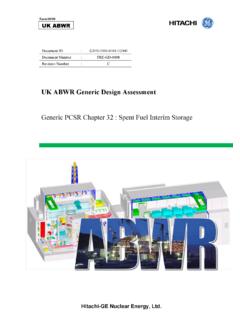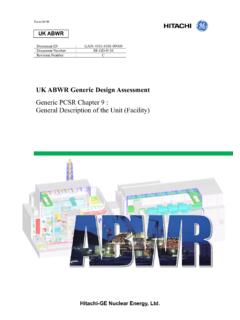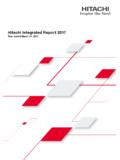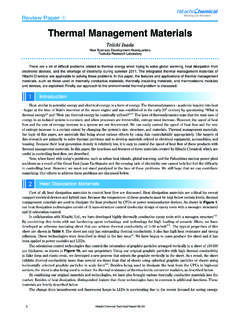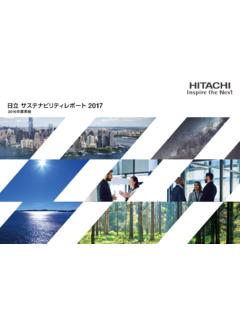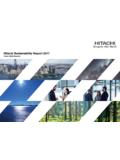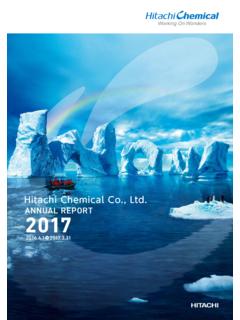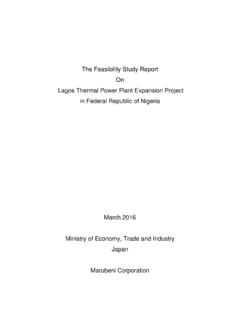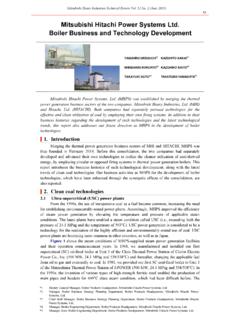Transcription of UK ABWR
1 Form10/00. UK ABWR. Document ID : GA91-9101-0101-28000. Document Number : SE-GD-0140. Revision Number : C. UK ABWR Generic Design Assessment Generic PCSR Chapter 28 : ALARP Evaluation hitachi -GE Nuclear Energy, Ltd. NOT PROTECTIVELY MARKED. Form05/01. UK ABWR Generic Pre-Construction Safety Report Revision C. DISCLAIMERS. Proprietary Information This document contains proprietary information of hitachi -GE Nuclear Energy, Ltd. ( hitachi -GE), its suppliers and subcontractors. This document and the information it contains shall not, in whole or in part, be used for any purpose other than for the Generic Design Assessment (GDA) of hitachi - GE's UK ABWR. This notice shall be included on any complete or partial reproduction of this document or the information it contains. Copyright No part of this document may be reproduced in any form, without the prior written permission of hitachi -GE Nuclear Energy, Ltd.
2 Copyright (C) 2017 hitachi -GE Nuclear Energy, Ltd. All Rights Reserved. GA91-9101-0101-28000 Rev. C. NOT PROTECTIVELY MARKED. NOT PROTECTIVELY MARKED. Form05/01. UK ABWR Generic Pre-Construction Safety Report Revision C. Table of Contents Executive Summary .. i Introduction .. Background .. Document Structure .. Purpose and Scope .. Purpose .. Development of the Standard ABWR .. Genesis of ABWR .. BWR Safety System Evolution Leading up to Standard ABWR .. BWR Reactor Pressure Vessel Evolution Leading up to Standard ABWR .. BWR RPV Internals Evolution Leading up to Standard BWR Materials and Chemistry Evolution Leading up to Standard BWR Containment Evolution Leading up to Standard ABWR .. Refuelling and Spent Fuel Storage .. Electrical and C&I Evolution Leading up to Standard ABWR .. Design for Environment .. Conclusion .. Development of ABWR after Kashiwazaki-Kariwa Units 6 and 7.
3 Response to the Fukushima Accident .. Lessons Learnt .. Basic Strategy for Safety Overview of Countermeasures .. Conclusion .. Strategy for the Demonstration of ALARP in GDA .. ALARP Evaluation ALARP Insights from Probabilistic Safety Assessment .. ALARP Insights from Beyond-Design-Basis Accident and Severe Accident Assessments .. The Development of the UK ABWR Design during GDA .. Design Decisions Arising from the Application of the ALARP Process .. Design Decisions Arising from Insights from the Use of PSA .. Design Decisions Arising from Insights from the BDBA and Summary of Design Changes Considered during GDA .. Conclusions .. References .. Appendix A. Example of the Use of MADA in ALARP Assessments .. A1. 28. ALARP Evaluation Ver. 0 i NOT PROTECTIVELY MARKED. NOT PROTECTIVELY MARKED. Form05/01. UK ABWR Generic Pre-Construction Safety Report Revision C. Executive Summary This chapter describes the high level arguments and evidence that demonstrate that the risks from the full lifecycle of the UK ABWR are as low as reasonably practicable (ALARP), as required by UK.
4 Law. This covers construction, commissioning, operation, maintenance and decommissioning. The level of argument related to construction, commissioning, operation, maintenance and decommissioning is commensurate with the design progress within GDA. This chapter traces the development of the UK ABWR design from the earliest commercial BWRs, and shows how the best practice at the time was incorporated at each stage of development. It also shows how different options were considered at each stage and how the safety of the design improved with each new generation. During GDA, the design has also developed, partly as UK Relevant Good Practice (RGP) has been adopted, and also through a process of systematically identifying options with potential risk benefits. Any of these risk reduction measures which have been deemed to be reasonably practicable have been incorporated into the design. This chapter describes the process used for the analysis of reducing risks to a level ALARP and describes some of the more important outcomes.
5 Further details of the outcomes are presented in the ALARP sections of individual PCSR chapters. Finally, the chapter gives a brief description and rationale for significant design changes that have arisen in the GDA process to reduce risks to levels that are ALARP. Thus, by tracing the evolution of the design and showing the continual improvement in safety, and by describing the GDA process of identifying further reasonably practicable improvements, the chapter concludes that there are no further reasonably practicable changes that could be made to reduce risks within the context of GDA. However, this does not preclude a future licensee from considering any further reasonably practicable measures that may reduce risk. Thus it is concluded that the UK ABWR design, as presented in GDA, has been developed to a point where there is high confidence that a future licensee would be able to operate the UK ABWR on a UK site achieving levels of risk which are both tolerable and 28.
6 ALARP Evaluation Executive Summary Ver. 0 i NOT PROTECTIVELY MARKED. NOT PROTECTIVELY MARKED. Form05/01. UK ABWR Generic Pre-Construction Safety Report Revision C. Introduction This chapter summarises the arguments and evidence that demonstrate that risks posed to the workforce and public from the construction, commissioning, operation, maintenance and decommissioning of the UK ABWR are As Low As Reasonably Practicable (ALARP). Background Nuclear Safety in the UK is based on the legal requirement that the risks to the workforce and public from a Nuclear Power Plant (or indeed any other industrial facility) should be reduced So Far As Is Reasonably Practicable (SFAIRP) or, equivalently, that risks should be demonstrated to be As Low As Reasonably Practicable. This chapter summarises the demonstration that the design of the UK. ABWR reduces risks SFAIRP during construction, commissioning, operation, maintenance and decommissioning, at a level proportionate to the design maturity in GDA.
7 Generally, and this applies throughout all Chapters of this PCSR for the UK ABWR, the acronym ALARP is used in preference to SFAIRP. Document Structure Most of the other chapters of the PCSR contain a section that summarises the ALARP justification relevant to that chapter with references to the Topic Reports that provide the detailed ALARP. justification. While individual chapters contain a section on ALARP, these are necessarily limited in their scope. Chapter 28 seeks to provide a high level summary of these individual chapters and also presents an integrated view of nuclear risk that is only possible by addressing together the totality of the structures, systems and components which make up the UK ABWR. An understanding of how the nuclear risk is distributed between all aspects of UK ABWR operation enables a designer, future licensee, and also a regulator to apply a proportionate approach to nuclear safety which has implications for assessing whether potential design changes may, or may not be reasonably practicable.
8 Section outlines the purpose and scope of the chapter. Section traces the development of the ABWR design from the earliest BWR designs showing how safety has been continuously improved as each generation has been developed, culminating in the standard Japanese ABWR Kashiwazaki-Kariwa Units 6 and 7. Section outlines the development of later ABWR plants after Kashiwazaki-Kariwa Units 6 and 7. The earthquake and tsunami that struck eastern Japan in March 2011 and the severe accident at the Fukushima Dai-ichi BWR plant led to major reviews of nuclear safety in plants around the world. These reviews led to a number of lessons being learned in Japan, the EU and the UK. How these lessons learned have been implemented in the design of the UK ABWR is the subject of Section Section outlines the strategy used to demonstrate that the risks associated with the ABWR. design in the UK are ALARP.
9 This is based on the implementation of the standard ALARP process generally used in the UK industry and insights from the Probabilistic Safety Assessment (PSA). developed for UK ABWR. 28. ALARP Evaluation Introduction Ver. 0 NOT PROTECTIVELY MARKED. NOT PROTECTIVELY MARKED. Form05/01. UK ABWR Generic Pre-Construction Safety Report Revision C. Section then describes the development of the UK ABWR design from the most recent designs in Japan, listing the design changes that have been identified from the need to implement UK and International good practice, from the application of a systematic ALARP analysis and from the insights from the PSA. Section provides the overall conclusions. 28. ALARP Evaluation Introduction Ver. 0 NOT PROTECTIVELY MARKED. NOT PROTECTIVELY MARKED. Form05/01. UK ABWR Generic Pre-Construction Safety Report Revision C. Purpose and Scope Purpose The purpose of Chapter 28 is to provide, at a high level, the arguments and evidence that the risks to the station workforce and the public from the construction, commissioning, operation, maintenance and decommissioning of the UK ABWR are ALARP.
10 This chapter shows how the development of the design from the earliest BWRs has continually adopted international good practice and explored options to reduce risk, with options deemed reasonably practicable being implemented as the design has developed. Scope This chapter discusses the high level approach taken for demonstrating ALARP across all aspects of the design and operation but leaves the detailed safety justification to the relevant PCSR chapters and more usually their supporting documentation (BSCs and TRs) referenced in each chapter. The approach to demonstrating that risks from the construction, commissioning, operation, maintenance and decommissioning of the UK ABWR are ALARP is based on a well-defined process that begins with the adoption of RGP and then continually looks for and identifies options to reduce risks. Any options that are determined to be reasonably practicable, that is, whose costs are not grossly disproportionate to the value of the risk reduction potentially achieved by their implementation, are then implemented.

